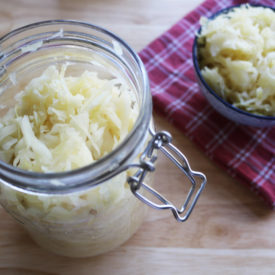
What are probiotics?
Probiotics are foods that contain living microorganisms that often belong to the bifido or lactic acid bacteria. Probiotics are live bacteria and yeasts that are beneficial for you, especially for your digestive system. We usually think of these as germs that cause diseases. But your body is full of bacteria, both good and bad. Probiotics are often called “good” or “helpful” bacteria because they help keep your gut healthy [1]. There are many findings that probiotics can contribute significantly to the balance of our intestinal flora [2]. The health of our intestines plays a huge role when it comes to our health in general. If the intestines are healthy, unwelcome invaders (harmful bacteria, parasites, yeasts), but also many chronic diseases have less chance of proliferating. Raw fermented foods provide living bacterial cultures that support our intestinal flora and strengthen our immune system. You can find probiotics in supplements and various foods [1]. Bacterial cultures are also used in conventional foods, e.g. yogurt, cheese or buttermilk. However, these reach the intestine only in small amounts, since the stomach acid has a pH value of only 1-1.5 which destroys the bacterial strains. Many types of bacteria are classified as probiotics. They all have different benefits, but most come from two groups:
Lactobacillus
This may be the most common probiotic. It’s the one you find in yogurt and other fermented foods. Different strains can help against diarrhea and may help people who can’t digest lactose – the sugar found in milk.
Bifidobacterium
You can find it in some dairy products. It may help ease the symptoms of irritable bowel syndrome (IBS) and some other conditions.
Saccharomyces boulardii
Saccharomyces boulardii is a yeast found in probiotic supplements. It appears to help fight diarrhea and other digestive problems.
What is fermentation?
Fermentation is the enzymatic conversion of organic substances. Fermentation is initiated by the adding of bacteria, yeasts and other biological cell cultures. Raw fermented food provides a multitude of living bacterial cultures. Living food containing natural and active lactic acid bacteria is particularly beneficial. Sauerkraut, for example, is a raw fermented vegetable at the top of the list of intestinal regulators. However, the focus here is on bacteria. Unfortunately, these are no longer present in standard, pasteurized foods such as Sauerkraut from the supermarket. Therefore, if you want to take full advantage of the power of natural probiotics, you can think about producing probiotic foods yourself.
The four most important advantages of fermented food:
- Nutrients are pre-digested by the bacteria contained in fermented products and are therefore easier to digest: the decisive factor is what arrives in ours cells.
- Creation of new health-promoting nutrients through fermentation
- Anti-nutrients (i.e. plant compounds that reduced the absorption of nutrients from the digestive system) in foods are degraded by fermentation
- The formation of many living lactic acid bacteria that restore your intestinal microbiome
Making your own probiotic foods
As already mentioned, fermentation plays a central role in the production of food and beverages. This does not only preserve the valuable probiotics inside of the food but also makes it more durable. Here you find a short overview of the most common fermented foods:
- Sauerkraut
- Kimchi
- Miso
- Tea
- Cocoa
- Coffee
- Cheese
- Yogurt
- Tofu
- Kefir
- Buttermilk
- Wine
- Beer
- Whisky
- Sourdough
When fermenting foods at home, keep in mind that if you do not do this properly (i.e. incorrect temperatures, fermentation times or unsterile equipment) fermentation can also go wrong. There is always a chance of contamination with harmful bacteria that can make you sick.
Probiotic recipes:
1. Sauerkraut [2]
- fermenting pot
- screw lenses
- cabbage masher
- 100g salt
- 5kg white cabbage
- Kitchen knife
- Kitchen towel
- Heavy weight
Fresh, firm white cabbage is best suited for the production of Sauerkraut. First remove the outer leaves and cut the white cabbage into fine strips. Then the white cabbage is to be layered in the fermentation pot alternately with a generous amount of salt. The next step is that you put the white cabbage strips into the pot and sprinkle it with salt. Each layer should be stamped with the cabbage masher until the cell sap covers the white cabbage. When this is done the next layer can be applied. The following ingredients can be added to white cabbage for refinement: sugar, juniper berries, carrots, apple slices. The fermentation pot is now filled according the recipe described above. The brine produced by tamping plays an important role in this process, because the oxygen-free milieu is what makes lactic acid fermentation possible in the first place. After all the white cabbage has been layered and stamped covered with brine, it is to be covered with the kitchen towel and to be weighted down. Then close the fermentation pot and store in a cool place. The kitchen towel should be changed about once every week. After 4-6 weeks the fermentation is finished and the Sauerkraut is ready to be eaten. It can also be filled into screw glasses together with the sap.
What kind of probiotics can be found in Sauerkraut?
During the fermentation process of Sauerkraut, the lactic acid bacteria living on the leaves begin to ferment the fermentable sugar contained in white cabbage. During this process there is quite a fluctuation from less acid-tolerant lactic acid bacteria to more acid-tolerant bacteria.
2. Pineapple-kefir-drink
- 2 sour apples
- 2 teaspoons lemon juice
- 500ml pineapple juice
- 500ml kefir
- 2 teaspoons brown sugar
- 2 msp. Dried chilli flakes
Peel the apples, cut them into small pieces, sprinkle them with lemon juice and puree everything with the remaining ingredients in a blender jug. The bacteria and yeasts contained in the kefir fungus allow the lactose to ferment in the milk (fermentation). Kefir contains live lactic acid bacteria, calcium and protein.
3. Fermented Carrots
- 700g carrots
- 15g ginger
- 34g salt
- 1l water
Clean and peel the carrots and cut them into fine slices. Finely dice the ginger. Mix carrots and ginger in a large bowl with 14g salt and refrigerate overnight. The following day, prepare a 2-percent brine: Heat 1l of water (must not boil!) and dissolve the remaining 20g of salt in it. Place the carrots with the juice in a sealable glass and press firmly into the glass with your hands. Fill with brine until the carrots are completely covered (just below the edge of the glass). Weigh down the carrots (e.g. with a small cup or clean stone). Close the glass and store it in a dark place at room temperature. After 2-3 days, the so called “wild fermentation“begins. Allow the glass to stand at room temperature until the vegetables lose their colour and the brine becomes cloudy. Now the fermented vegetables are ready to eat.
Durability: unopened in fridge 1 month. Consume opened within two weeks.
Fermented Vegetables
In general, any raw edible vegetable is suitable, but vegetables which are very green and therefore have a high chlorophyll content (e.g. broccoli) are less suitable. The vegetables should not get into contact with oxygen, otherwise unwanted yeasts may develop. Therefore close the vessels. The resulting carbon dioxide is heavier than oxygen and thus lies under the oxygen in the glass during fermentation. It protects the vegetables from oxygen. Under an aerobic condition (without oxygen), the lactic acid bacteria begin to turn the sugar contained in the vegetables into lactic acid. Through this reaction, the bacteria create an acid environment in which only they can proliferate, but not harmful bacteria. This makes the vegetables durable.
